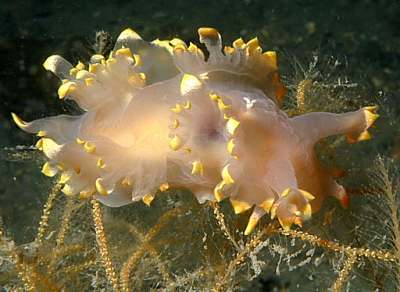
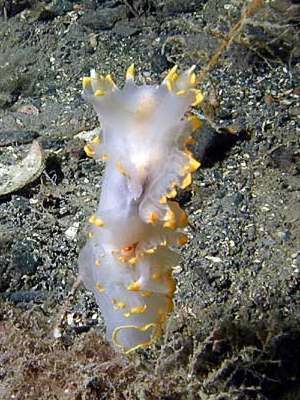
Lomanotus genei
Verany, 1846
Order: NUDIBRANCHIA
Suborder: DENDRONOTINA
Family: Lomanotidae
DISTRIBUTION
Europe from west coast of Scotland to the Mediterranean coast of France and Italy
PHOTO
East coast of Loch Linnhe, south of Eilean Balnagowan, Scotland. Depth: 16.5 metres. Approx 90mm long. Photo: Jim Anderson
The animal ranges in colour from translucent white to red. In all cases the cerata-like pallial processes, the rhinophore sheaths, and the posterior end of the foot are tipped with opaque yellow. The pallial processes are arranged along the edge of the mantle which forms a sinuous rim along each side of the body. In juveniles the pallial processes are arranged as separate papillae, but in adults they are close together forming a continuous frill around the mantle edge.
According to Thompson & Brown (1984) the species is nearly always found feeding upon the calyptoblastic hydroid Nemertesia ramosa in coastal waters down to 90 m. It is normally slow-moving, but if abruptly disturbed may swim clumsily by means of lateral contractions of the whole body, the most posterior cerata helping to form a propulsive keel. The adults may reach 94 mm in length.
Reference:
• Thompson, T.E. & Brown, G.H. (1984). Biology of Opisthobranch Molluscs. Vol II. The Ray Society. London.
Rudman, W.B., 2003 (July 30) Lomanotus genei Verany, 1846. [In] Sea Slug Forum. Australian Museum, Sydney. Available from http://www.seaslugforum.net/find/lomagene
Related messages
Two colour forms of Lomanotus genei
April 16, 2007
From: Karen Williams
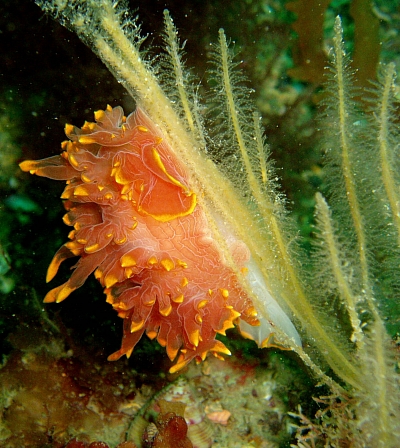
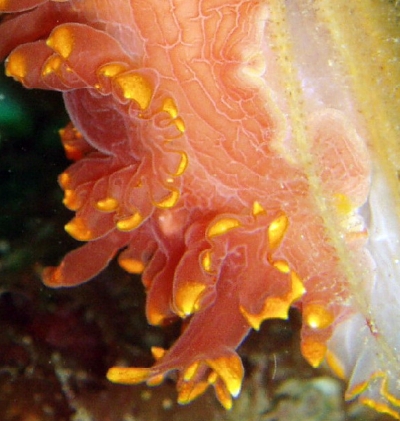
Dear Bill
Thank you for your information on Pleurobranchus membranaceus [message #19294 ].
I thought you might be interested in these images of Lomanotus genei. Although they were taken over 18 months ago I thought they might be worth sending as I believe the find was quite unusual. Originally there appeared to be only the red colour form but when turning over the hydroid it was feeding on the white form was revealed. I note there is another record of two colour forms [#17144 ].
Locality: Start Point, GPS Position: 50 13.391 N, 03 38.170 W, 15 metres, South Devon, England, UK, English Channel, 18 June 2005, Gently sloping seabed of gravel, sand and cobbles with rocky outcrops. Length: 60 mm. Photographer: Karen Williams.
Regards
Karen Williams
karenalwilliams@btinternet.com
Williams, K.A.L., 2007 (Apr 16) Two colour forms of Lomanotus genei. [Message in] Sea Slug Forum. Australian Museum, Sydney. Available from http://www.seaslugforum.net/find/19491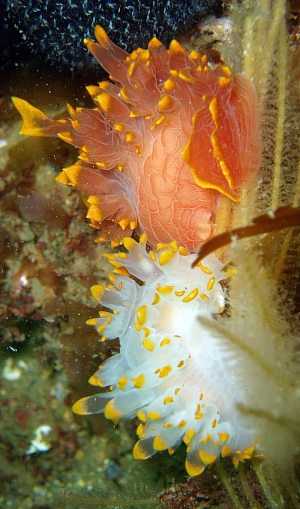
Dear Karen,
This is a good find. The white one was well hidden behind the pink one. I have included a close-up of the head region of the pink one to show the rhinophores sheath [at bottom of photo] and some of the sinuous foldiing of the edge of the mantle and the attached 'cerata'
Best wishes,
Bill Rudman
Two colour forms of Lomanotus genei
July 20, 2006
From: Wilfried Bay-Nouailhat
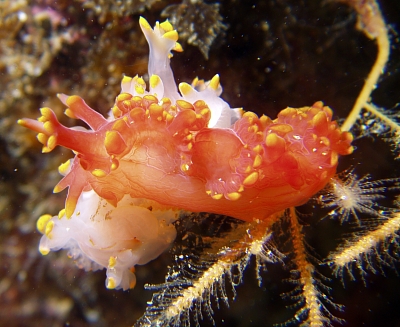
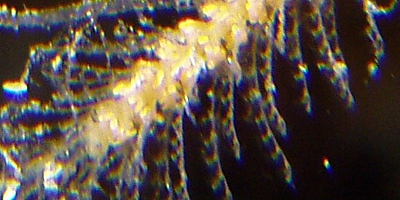
Dear Bill,
Thanks for your information about Cadlina laevis [message #16923 ]
Here is a photo of the two colour varieties of the nudibranch Lomanotus genei on the same hydroïd, Nemertesia ramosa
Locality: Pen Marmouset, Iles Glénan, Finistère sud, 18 metres, France, Atlantic Ocean, 14 may 2006, On hydroid. Length: 70 mm. Photographer: Wilfried Bay-Nouailhat.
Best wishes
Anne and Wilfried Bay-Nouailhat
contact@mer-littoral.org
Bay-Nouailhat, W., 2006 (Jul 20) Two colour forms of Lomanotus genei. [Message in] Sea Slug Forum. Australian Museum, Sydney. Available from http://www.seaslugforum.net/find/17144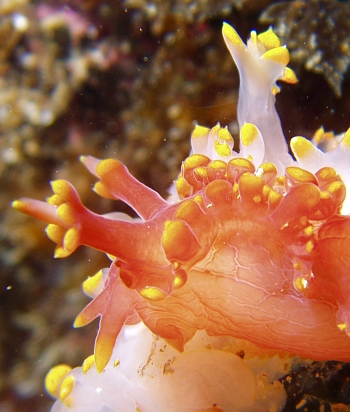
Thanks Willy,
When I saw your photo the thing that struck me, other than the two colour forms, was how large the animals were in relation to the hydroid polyps they eat. It didn't seem probable that they would delicately nip of one polyp at a time. Then I noticed the photos on the Fact Sheet which show Lomanotus on long bare knobbed stalks. I had wondered what they were and now realise they are stalks of Nemertesia with all the polyp-bearing side branches missing. Lomanotus apparently strips off all the side branches and eats them polyps and all. I assume the knobs on the central stalk of the Nemertesia are the gonotheca, specialised polyps which are for breeding not feeding. Very interesting
Best wishes,
Bill Rudman
Re: Lomanotus genei with its eggs
May 27, 2006
From: Hervé Limouzin
Concerning message #16652:
Dear Bill,
Thanks for publishing my Lomanotus picture. You are right: it was not on Nemertesia antennina but on N. ramosa
About red Lomanotus, I haven't seen any this year, but some "white" specimens had a pink-pale red - translucent color. I didn't see anything that would explain that during my dives because they were all in the same place.
Best wishes
Hervé Limouzin
limouzin.herve@wanadoo.fr
Limouzin, H., 2006 (May 27) Re: Lomanotus genei with its eggs. [Message in] Sea Slug Forum. Australian Museum, Sydney. Available from http://www.seaslugforum.net/find/16707Dear Hervé,
Thanks for checking the hydroid identification. Your inormation on finding the colour forms together would suggest the colour difference is genetic rather than the result of some environmental influence or food additive, but clearly it is another thing to put on our list of things 'to do'.
Best wishes,
Bill Rudman
Re: Lomanotus genei from west coast of Scotland
May 24, 2006
From: Jeff Goddard
Concerning message #10591:
Hi Bill,
I just noticed that the Lomanotus genei in Jim Anderson's upper photo [message #10591] is carrying a parasitic copepod (two small, white egg sacs can be seen protruding the dorsum of the slug). Thompson & Brown (1984) note that Cornet & Marche-Marchad (1951) reported that L. genei from Brittany (France) are sometimes infected with Spanchnotrophus insolens.
-
Cornet, R. and Marche-Marchad, I. (1951) Inventaire de la faune marine de Roscoff, Mollusques. Travaux Station Biologique Roscoff, Suppl. 5:1-80.
-
Thompson, T.E. & Brown, G.H. (1984) Biology of Opisthobranch Molluscs Vol II. Ray Society, London.
Best wishes,
Jeff
goddard@lifesci.ucsb.edu
Goddard, J.H.R., 2006 (May 24) Re: Lomanotus genei from west coast of Scotland. [Message in] Sea Slug Forum. Australian Museum, Sydney. Available from http://www.seaslugforum.net/find/16689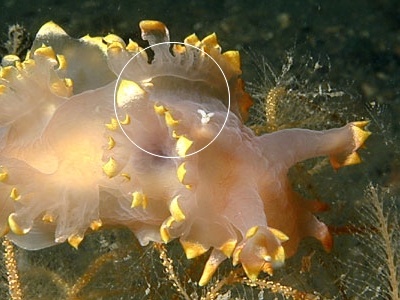
Good find Jeff,
In the slightly larger version of Jim's photo there seem to be two pairs of tell-tale copepod egg masses. The one on the right is much clearer and as you suggest there seems to be an opaque white mass beneath the skin of the nudibranch indicating the rpesence of a parasitic copepod rather than the ubiquitous free-living ones often found scurrying over nudibranchs [see top photo on Symbiosis Fact Sheet ]
Best wishes,
Bill Rudman
Lomanotus genei with its eggs
May 23, 2006
From: Hervé Limouzin
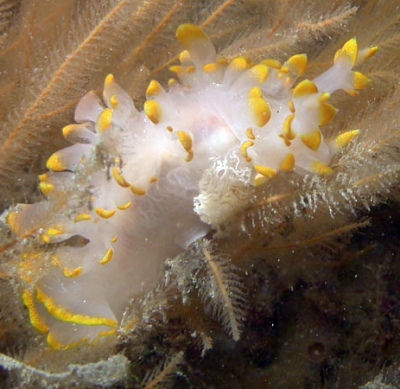
Dear Bill,
I was diving in le Magouer-Ria d'Etel, Brittany, France recently and i'm pleased to send you this picture of the nudibranch Lomanotus genei with his egg ribbon.
Photo at 12 m, water temperature 9°C, on Nemertesia antenninafrom H. Limouzin. Nikon Coolpix 4500 with Ikelite housing. [note message #16707 correcting hydroid identification to Nemertesia ramosa ]
During this dive, we observe 3 Lomanotus from 2 cm to 7 cm (the biggest, with its eggs). There were only white specimens. Do you know about the red ones ? Are there specific conditions for this specific color ? (last year, we saw more than 20 white animals and only 2 red).
Best regards.
Hervé Limouzin
limouzin.herve@wanadoo.fr
Limouzin, H., 2006 (May 23) Lomanotus genei with its eggs. [Message in] Sea Slug Forum. Australian Museum, Sydney. Available from http://www.seaslugforum.net/find/16652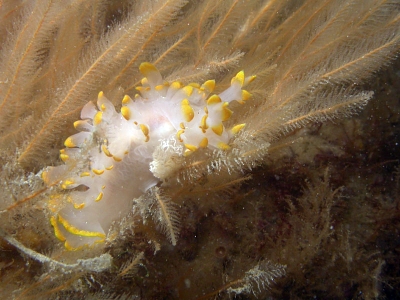
Dear Hervé,
Thanks for this photo, of a species which is rarely reported. It is useful to have another photo of the eggs of this species [see message #10591]. Picton & Morrow (1994) describe the egg string of L .genei as 'a string of eggs wound irregularly around the hydroid' and compare it with L. marmorata which they say lays its egg string 'as a tight zigzag along the stem of the hydroid'.
I am not sure if there is any information on why some are red and some are white. Mu understanding is that there has been quite a lot of confusion surrounding this species and L. marmorata and it would be good to learn more about the biology of all the European 'forms' or 'species'. Are you sure about the identity of the hydroid? Picton & Morrow suggest that L. genei is usually found on Nemertesia ramosa while Lomanotus marmoratus is found on Nemertesia antennina
Best wishes,
Bill Rudman
Lomanotus from Croatia?
April 5, 2006
From: Mat Vestjens
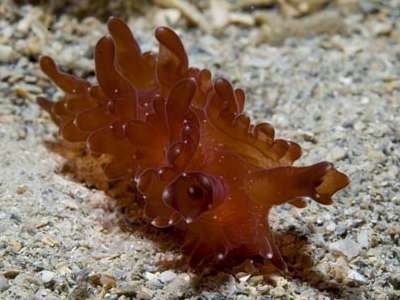
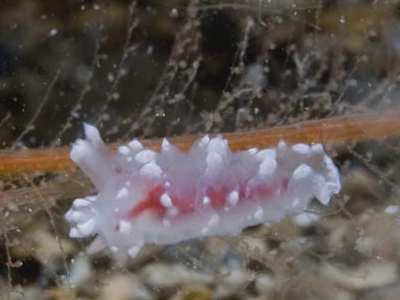
Hello Bill,
Today April 2nd, we found the two attached specimen together on a hydroid branch, (I think it was Nemertesia ramosa). Searching in my books and on the web, I think they must be a Lomanotus species. I can not make out what species, or if they are both of the same species. The white one was very small, about 5 mm, and the brown one was about 40 mm long. The way the rhinophores and processes look to me very typical for Lomanotus. Can you help me on this?
Locality: Selce, 20 metres, Croatia, Adriatic sea, 02 April 2006, Gravel. Length: 5 and 40 mm. Photographer: Mat Vestjens.
Best regards,
Mat Vestjens
annenmat@natuurlijkmooi.net
Vestgens, M., 2006 (Apr 5) Lomanotus from Croatia?. [Message in] Sea Slug Forum. Australian Museum, Sydney. Available from http://www.seaslugforum.net/find/16228Dear Mat,
We don't know a lot about these animals as they are seldom reported but I suspect your animals are both Lomanotus genei which is quite variable in colour. Hopefully some local experts can give us more information
Best wishes,
Bill Rudman
Lomanotus genei from Scotland
March 14, 2006
From: Sean Ferris
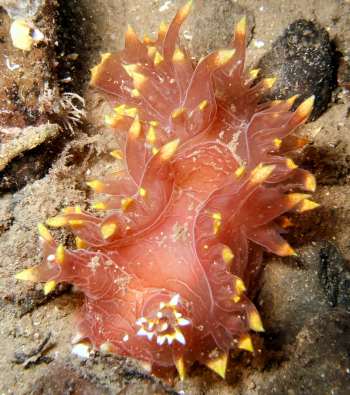
Hi there,
I wrote to Jim Anderson about this nudibranch just to confirm that it is a Lomanotus geneiso he said to show you it.
It was about 8 to 9ins long
Locality: Isle of Arran, 16m, Clyde, 26/02/06, sand & gravel. Length: about 8 to 9 ins long. Photographer: Sean Ferris.
Sean Ferris
ferrissean@yahoo.com
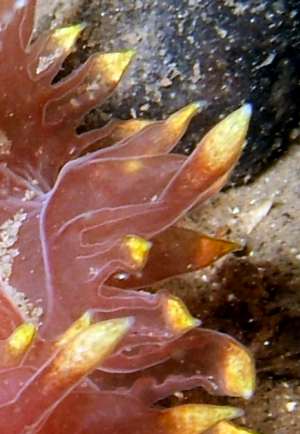
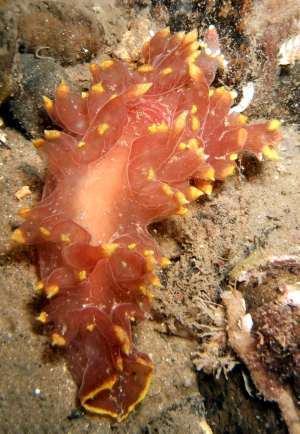
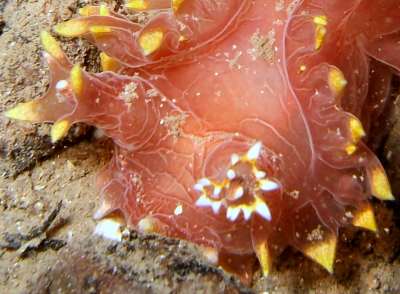
Dear Sean,
I'm glad Jim asked you to forward this to the Forum as it we haven't photos of this reddish colour form. Your photos also show the structure of the 'cerata' along the side of the mantle very well. In the close-up I have included you can see rounded ducts running along the edges of each ceras. These are blood filled and presumably act as gills. The flower-like rhinophore pockets in the close-up alongside show that these nudibranchs are dendronotoideans, related to Tritonia, Bornella and Doto.
Best wishes,
Bill Rudman
Lomanotus genei from west coast of Scotland
August 1, 2003
From: Jim Anderson

Dear Bill,
I found these animals yesterday while shore diving on the east coast of Loch Linnhe south of Eilean Balnagowan, western Scotland.
They were both approx 90mm long and separated by 30 metres horizontally at 16.5 metres depth in 13 deg C water. An identical egg spiral as in the lower left photo was also noted near the animal in the upper photo and makes me suspect that this may be the spawn of these animals.
I hope these images and information on Lomanotus genei are of use to the Forum.
Kind regards,
Jim Anderson
jander4454@blueyonder.co.uk
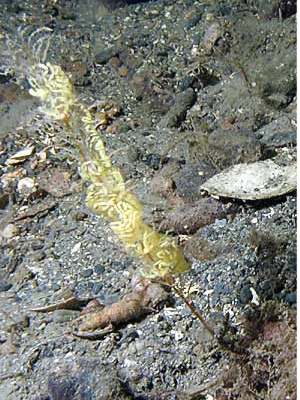

Dear Jim,
Thanks very much for these photos which are a valuable addition to the Forum. The eggs are almost certainly those of Lomanotus genei which are described by Picton & Morrow (1994) as 'a string of eggs wound irregularly around the hydroid'. In fact if you look at the animal in the lower right photo it looks like it is laying an egg string - see yellow loop at bottom of animal
Best wishes,
Bill Rudman
